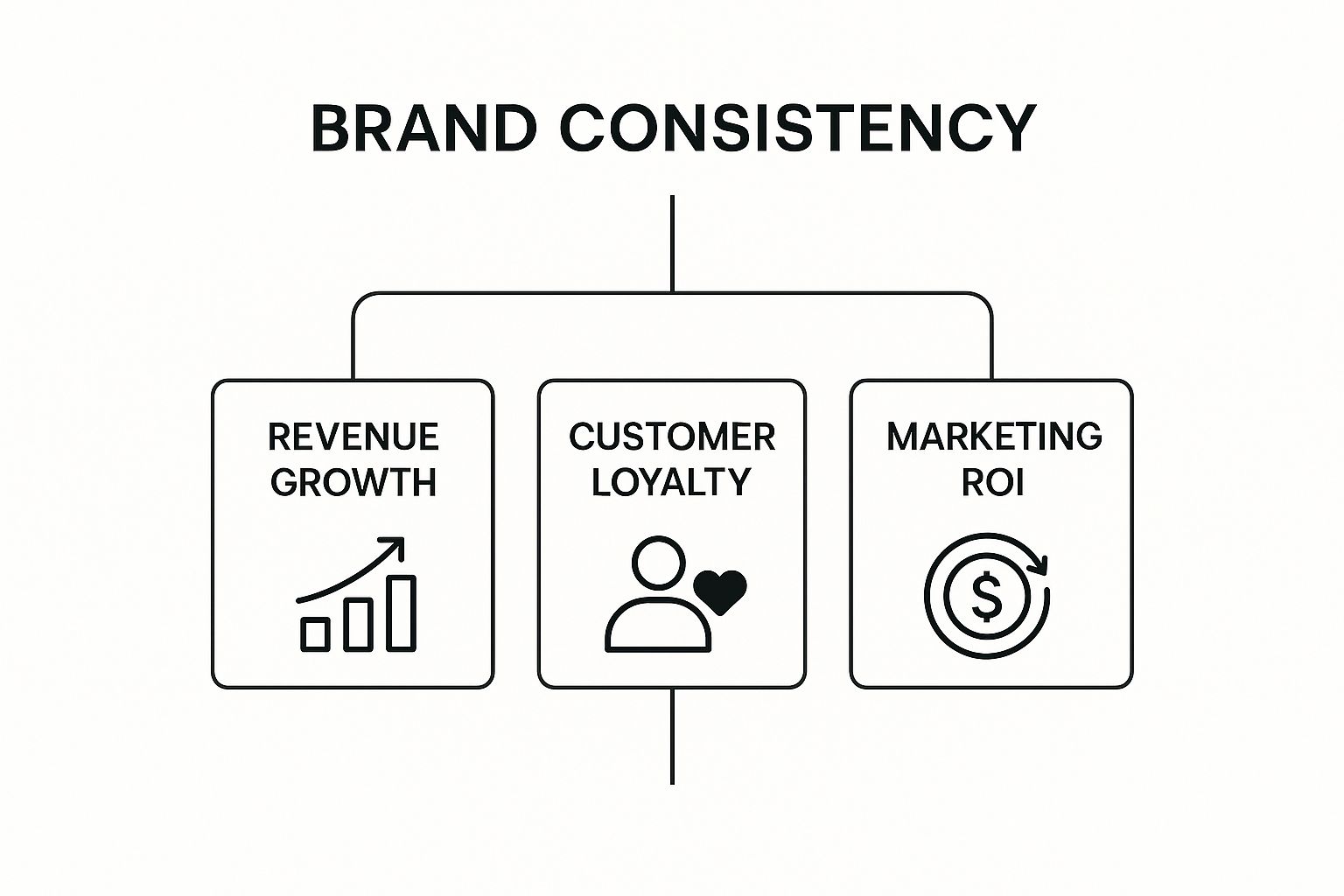Ever wonder what makes a brand feel… right? Like you just get it, no matter where you see it? That's brand consistency in action.
It’s the practice of making sure your brand’s core message, its values, and its look and feel are the same everywhere. A customer should get the same cohesive experience whether they’re scrolling your social feed, browsing your website, or opening an email from you. This goes way deeper than just slapping your logo on everything; it’s about being predictably you, every single time.

What Is a Consistent Brand Experience, Really?
Think of your brand like a person. You expect your friends to act a certain way, to have a consistent personality. Your customers feel the same way about your brand. Consistency is how you show up for them, time and time again, building a relationship based on trust.
It’s the unifying thread that ties every part of your business together. We're talking about the little things—the color of a button on your site, the tone of a customer support email, the feel of your packaging—all telling the same story. When every detail works in harmony, you build a powerful, trustworthy brand that stands out.
To really nail this, you have to be clear on what you stand for. The following table breaks down the core pillars that hold up a consistent brand experience.
The Core Pillars of Brand Consistency
| Pillar | What It Covers | Why It Matters for Consistency |
|---|---|---|
| Visual Identity | Your logo, color palette, typography, imagery, and overall design style. | Creates instant recognition and a unified look across all marketing materials, from your website to your business cards. |
| Brand Voice & Tone | The personality your brand communicates through words—friendly, formal, witty, authoritative. | Ensures your messaging feels familiar and on-brand, whether it's in a tweet, a blog post, or a product description. |
| Core Messaging | Your mission, vision, values, and unique value proposition. The "why" behind what you do. | Aligns all your communications around a central purpose, making your brand's story clear and compelling. |
| Customer Experience | How customers interact with your brand at every touchpoint, from sales to support. | Guarantees a predictable and positive experience that reinforces your brand promise every step of the way. |
Each pillar works together to create a seamless experience. Get one wrong, and the whole structure can feel a bit wobbly.
Why It’s a Game-Changer for Your Business
This isn't just about looking good; it's a direct line to your bottom line. A consistent brand feels more professional and reliable, which makes customers far more likely to trust you with their money.
The numbers don't lie. Sticking to a consistent brand presentation can boost revenue by 10-20% for many businesses. And some companies report even higher gains. When people know what to expect, they feel more comfortable hitting that "buy" button.
True brand consistency transforms your business from just another option into the option. It builds subconscious recognition and fosters a sense of dependability that marketing campaigns alone cannot achieve.
This is a fundamental piece of your overall brand development strategy. It helps you carve out a distinct space in your customers' minds, making your brand impossible to forget.
Not sure if your brand is sending a clear signal? It might be worth doing a quick vibe test for your brand to see how you’re perceived. It’s a simple way to make sure every touchpoint is contributing to a strong, unified identity that connects with your audience and builds lasting loyalty.
Why Consistency Is Your Greatest Growth Tool
A strong brand does more than just look good—it gets results. Think of brand consistency as the engine that powers your growth, turning abstract ideas like "trust" and "recognition" into real revenue and fiercely loyal customers. It’s the difference between a business that has to fight for every single sale and one that people are naturally drawn to.
When your brand shows up the same way everywhere, it builds a deep sense of reliability. That predictability is what gives a potential customer the confidence to click "buy." Someone who sees a consistent message on your social media, your website, and in an email feels secure in their decision. It just feels right.
Building Trust That Translates to Revenue
In today’s market, trust is everything. And consistency is how you earn it, one interaction at a time. Every time you present a unified front, you reinforce your brand's promise and solidify your reputation as the dependable choice. This isn't just a feel-good thing; it has a direct impact on your bottom line.
This infographic breaks down how a consistent brand creates a positive feedback loop for your business.

As you can see, it all connects. A steady brand experience leads to more revenue, happier customers who stick around, and a much better return on your marketing dollars.
Driving Profitability and Loyalty
The link between consistency and profitability is undeniable. Companies that keep their brand experience steady see their profits grow at a much higher rate—we're talking double the gains of businesses that are constantly changing things up.
Just look at Nike. The iconic swoosh and "Just Do It" have been cultural staples for nearly four decades. That’s the power of sticking to your guns. As you can read on Funnel.io, this kind of long-term consistency builds global recognition and unshakable market power.
A consistent brand doesn’t just sell a product once. It creates an experience that people want to come back to. It’s the invisible force that turns a one-time buyer into a lifelong advocate for your business.
This is how you turn customers into true fans. They don't just buy from you; they believe in what you stand for. That emotional connection is what separates the flash-in-the-pan brands from the ones that endure for generations.
Maximizing Your Marketing Spend
Ultimately, consistency makes your marketing work smarter, not harder.
When your brand is instantly recognizable, you spend way less time and money just introducing yourself. Every new campaign builds on the foundation of the last, creating a compounding effect that strengthens your place in the market over time. It makes it easier to stand out and even easier to track what's working. (If you want to dive deeper, check out our guide on how to measure brand recognition).
Your cohesive brand promise becomes your most powerful asset, ensuring every dollar you invest delivers a much bigger return.
The Building Blocks of a Cohesive Brand
Think of brand consistency like a well-built house. It’s not just one thing that makes it strong; it’s how the foundation, walls, and roof all work together. To create a brand that feels solid and dependable, you have to get several core components aligned, making sure each one supports the others.
These building blocks are the practical elements you can actually control, and getting them right is what separates the memorable brands from the ones that just fade into the background. When every piece tells the same story, you create a seamless experience that builds real recognition and trust.

Visual Identity: The Look of Your Brand
Your visual identity is the most immediate way people recognize you. It’s the face of your brand, and it needs to look the same everywhere. This goes way beyond just your logo; it's a complete system of design elements that work in concert.
- Logo and Variations: Your main logo and any alternate versions need to be used correctly across every platform, from your website header to your social media profile pics.
- Color Palette: Your brand colors spark specific emotions. Sticking to a defined palette makes sure all your visual materials, like ads and presentations, feel like they came from the same place.
- Typography: The fonts you pick for your marketing materials and website help shape your brand’s personality—whether it feels modern and clean or traditional and elegant.
- Imagery: Your photography and illustration style should have a consistent vibe, reinforcing your brand’s overall aesthetic.
Nail these elements, and customers can spot your brand in a split second, even without seeing your name.
Brand Voice and Tone: The Personality of Your Brand
If your visual identity is how your brand looks, your voice and tone are how it speaks. This is the distinct personality that shines through in all your written and spoken communication. It's what makes your brand feel human.
Your brand voice is your fixed personality—are you authoritative, witty, friendly, or inspiring? Your tone, on the other hand, shifts with the situation. For instance, your voice might always be helpful, but your tone will be more serious on a support page than in a celebratory social media post.
A consistent voice ensures your brand sounds like itself everywhere, from an email newsletter to a video script. This verbal identity is just as crucial as your visual one for building a memorable brand character.
Defining this is a huge step. To get a better handle on it, check out our guide on creating effective brand voice guidelines your whole team can actually follow.
Core Messaging and Customer Experience
Beyond looks and voice, two final pieces tie everything together.
- Core Messaging: This is what you stand for—your mission, your values, and what makes you different. Every single piece of content, from a blog post to an ad, should echo these key messages. You're telling a clear story about why you exist and what problems you solve.
- Customer Experience: Consistency has to carry through to every single interaction. The feeling a customer gets from your sales process, your product quality, and your support team has to match the promises your marketing is making.
To make sure your brand's presence is unified everywhere, creating solid social media branding guidelines is a critical piece of the puzzle. By aligning these four components, you create a powerful, unified brand experience that really connects with your audience and stands the test of time.
Learning from Brands That Master Consistency
Theory is great, but seeing brand consistency in action? That’s where the real lessons are. The world’s most iconic brands aren’t just selling you something; they’re selling a predictable, reliable experience. By pulling back the curtain on how they do it, we can find some powerful takeaways for businesses of any size.
Think about Apple. From the minimalist feel of their products to the clean, intuitive layout of their website, all the way to the calm, knowledgeable vibe of their store employees—every single touchpoint reinforces a core promise of simplicity and innovation. The experience is so seamless that you know you’re in the Apple ecosystem, even if you can’t see the logo.
The Power of a Unified Promise
This kind of cohesion is anything but accidental. It’s the result of a disciplined strategy that makes sure every tiny detail tells the same story. Coca-Cola is another masterclass in this. For over a century, its brand has been synonymous with happiness and togetherness.
That feeling doesn’t just come out of nowhere. It's built through a few key elements:
- Consistent Visuals: That iconic red and the Spencerian script? Instantly recognizable, no matter where you are in the world.
- Unified Messaging: Their ad campaigns consistently hit on themes of joy, sharing, and refreshment.
- Predictable Experience: A Coke tastes the same whether you’re in Tokyo or Tennessee, delivering on a simple but powerful brand promise.
When a brand delivers a consistent experience, it stops being just a product. It becomes a reliable part of its customers' lives. This builds an emotional connection that is incredibly difficult for competitors to break.
This dedication to consistency has a massive financial upside. Tech companies, for instance, have collectively become the largest industry in global brand value, worth a staggering $1.3 trillion—with consistent branding as a key driver. Just look at Tesla, which saw its brand value shoot up by 184% in a single year, largely fueled by its unwavering brand narrative.
Consistency at Every Scale
But you don’t need a global footprint to make consistency work. Think about that local coffee shop everyone in the neighborhood loves. Its success almost always comes down to a consistent experience: the friendly greeting from the baristas, the reliably perfect latte, and the cozy, familiar atmosphere.
Each of these things contributes to its unique brand identity. This local hero proves that the principles of consistency—knowing who you are and showing up that way, every single time—are universal.
If you’re ready to dig deeper, our guide on building a strong brand offers actionable steps you can take today. By learning from these examples, you can start shaping a brand that isn’t just seen, but remembered and trusted.
How to Build and Maintain Brand Consistency
So, you’ve got a killer brand strategy. Now what? Turning that vision into a real-world, consistent experience for your audience is where the real work begins. It’s all about creating a system that helps your team make the right choices, every single time.
Without a solid roadmap, even the best intentions can lead to a brand that feels scattered and confusing. This is how you move from theory to action. Building and maintaining brand consistency comes down to a few key things: creating clear rules, training your team, and using the right tools to make it all second nature. The goal isn’t to stifle creativity—it’s to build a strong foundation for it to grow on.
Create a Comprehensive Brand Style Guide
If there's one tool you absolutely need to maintain brand consistency, it’s a brand style guide. Think of this as your brand’s bible. It’s the single source of truth that lays out all the rules for how your brand should look, sound, and act. It gets rid of the guesswork and makes sure everyone, from the marketing department to the sales team, is speaking the same language.
A great guide is so much more than just a logo and a few color codes. It’s a detailed blueprint for your entire brand presence. To build one that actually works, you’ll want to learn how to create brand guidelines that cover every base, from your visual identity all the way to your core messaging pillars.
At a minimum, your guide needs to nail down:
- Visual Rules: This covers proper logo usage (and just as importantly, what not to do), your official color palette with specific codes (like HEX and RGB), and your typography hierarchy for headings and body text.
- Voice and Tone Guidelines: This is where you explain your brand’s personality. Give real examples of on-brand language and maybe even a list of words or phrases to avoid. It’s all about making sure your messaging always sounds like you.
- Mission and Messaging: It never hurts to reiterate your company’s mission, values, and key value propositions. This keeps all communication grounded in your purpose.
A brand style guide isn’t a one-and-done project; it’s a living document. It needs to be easy for every employee and partner to access, acting as the final word on all creative and communication decisions.
A well-structured style guide is your best defense against brand drift. Here’s a quick checklist of the essential elements to include.
Essential Elements of a Brand Style Guide
A checklist of must-have components for creating a comprehensive and effective brand style guide.
| Category | Specifics to Include | Purpose |
|---|---|---|
| Brand Foundation | Mission, vision, core values, brand story, target audience personas. | Grounds all creative work in the core purpose and identity of the brand. |
| Logo Guidelines | Primary & secondary logos, clear space, minimum size, incorrect usage examples. | Ensures the brand's most recognizable asset is used correctly and consistently. |
| Color Palette | Primary, secondary, and accent colors with HEX, RGB, and CMYK codes. | Maintains visual harmony and triggers brand recognition across all materials. |
| Typography | Brand fonts, font hierarchy (H1, H2, body), sizing, and spacing rules. | Creates a consistent and readable text experience online and in print. |
| Voice and Tone | Brand personality adjectives, grammar rules, examples of on-brand copy. | Ensures the brand's communication style is consistent and authentic. |
| Imagery Style | Guidelines for photography, illustration, and iconography. Mood board. | Creates a cohesive visual mood and prevents the use of off-brand visuals. |
Having these components clearly defined removes ambiguity and empowers your team to create on-brand work confidently.
Empower Your Team with Training
Your brand guidelines are only as good as the team using them. That's why internal training is so important—it’s the bridge between having a document and seeing it come to life. Your employees are your brand champions, and they need to feel confident in their roles.
Set up regular sessions to walk new hires and existing team members through the style guide. But don't just read the rules off a slide. Explain the why behind them. When your team understands how consistency builds trust and helps the company grow, they’ll be much more invested in keeping things on track.
Leverage Technology and Regular Audits
Let's be real: trying to maintain consistency across a growing business is nearly impossible without the right systems. A Digital Asset Management (DAM) platform can be a game-changer here. Think of it as a central library for all your approved brand assets—logos, images, templates, you name it—ensuring everyone is always using the latest and greatest versions.
Finally, you can't fix problems you don't know exist. That's where regular brand audits come in. Every so often, take a hard look at all your customer-facing channels—your website, social media profiles, email campaigns, and ads. Check them against your guidelines to catch any inconsistencies before they become big issues. This proactive approach protects your brand’s integrity and keeps the cohesive experience your customers expect.
Navigating Common Consistency Challenges
Let’s be honest: perfect brand consistency isn't a "set it and forget it" kind of deal. It's a constant effort. As your business grows, keeping that unified brand presence gets trickier, and you're going to run into new hurdles. The key is to get ahead of these challenges to protect the trust you’ve worked so hard to build.
Without a game plan, your brand can get watered down, fast. New team members come on board, you add another social media channel to the mix, and suddenly the risk of sending mixed messages skyrockets. It's a classic growing pain for almost every business.

Overcoming Brand Dilution
One of the biggest obstacles you'll face is brand dilution. This is what happens when your core message gets distorted or weakened as more people start creating content for you.
Maybe the sales team whips up their own presentation deck, or a social media manager goes rogue with a meme format that’s a little… off-brand. Each one of these little deviations might seem harmless, but over time, they chip away at your brand’s impact.
To fight this, you need a system that gives your team freedom but keeps everyone on the same page.
- Create Accessible Brand Assets: Get all your approved logos, images, and presentation templates into one central, easy-to-find digital library. When the right assets are just a click away, nobody’s tempted to create their own visuals from scratch.
- Establish Clear Approval Workflows: Put a simple review process in place for any new marketing materials. This just means a final set of eyes checks for consistency before anything goes out the door, stopping off-brand content in its tracks.
- Use Smart Templates: Build out some pre-designed templates for the common stuff—social posts, email newsletters, sales sheets. This gives your team a head start, letting them create what they need quickly without ever straying from the brand's look and feel.
Maintaining consistency isn’t about killing creativity. It's about building a strong framework so that creativity can shine in a way that actually reinforces the brand. It turns every single person on your team into a confident brand ambassador.
Aligning Cross-Channel Messaging
Another huge challenge is keeping your message straight across all the different places you show up. The way you talk in a professional LinkedIn article is obviously going to be different from a quick, fun TikTok video. The trick is to adapt your delivery without changing your core message.
This really comes down to deeply understanding your brand voice and who you're talking to on each channel. If you keep your core values and what you offer front and center, you can tailor the execution for different platforms while the underlying story stays the same. That's how you build a truly cohesive experience and save your audience from a whole lot of confusion.
A Few Lingering Questions
Got a few more questions rattling around about brand consistency? Totally normal. Let's tackle some of the most common ones that pop up.
How Often Should We Actually Update Our Brand Guidelines?
Think of your brand guidelines as something that evolves, not something you tear down and rebuild every few months. A good rhythm is a minor review once a year—just to make sure everything still feels fresh and aligned with where your business is headed.
As for a major overhaul? Only do that when you’re making a huge business pivot or a full-on rebrand, which usually happens every 5-7 years. The goal is strategic evolution, not constant change that just ends up confusing everyone.
What's the Real Difference Between Brand Identity and Brand Consistency?
It's actually pretty simple.
Your brand identity is what you are—it’s your logo, your color palette, your tone of voice. It's the collection of all your brand assets.
Brand consistency is the discipline of using that identity the same way, everywhere, all the time. Your identity is just a cool idea on paper until consistency brings it to life in the real world.
Can We Still Be Creative and Be Consistent?
One hundred percent. In fact, you have to be.
Good brand guidelines don't put you in a creative prison; they build a sandbox to play in. They set the core rules—the non-negotiables—but leave plenty of room for your team to run, experiment, and create.
For instance, your brand voice might be "witty and insightful." That's a clear direction, but there are a million different ways to write a witty tweet or an insightful blog post. The guidelines provide the guardrails, but the creativity comes from your team driving on the road.
Ready to build a brand that people remember and trust? At Creativize, we connect you with incredible local professionals who live and breathe branding, design, and more. Find the perfect creative partner to bring your vision to life.

